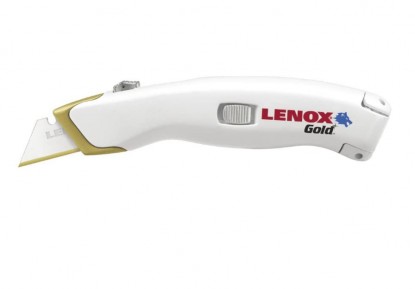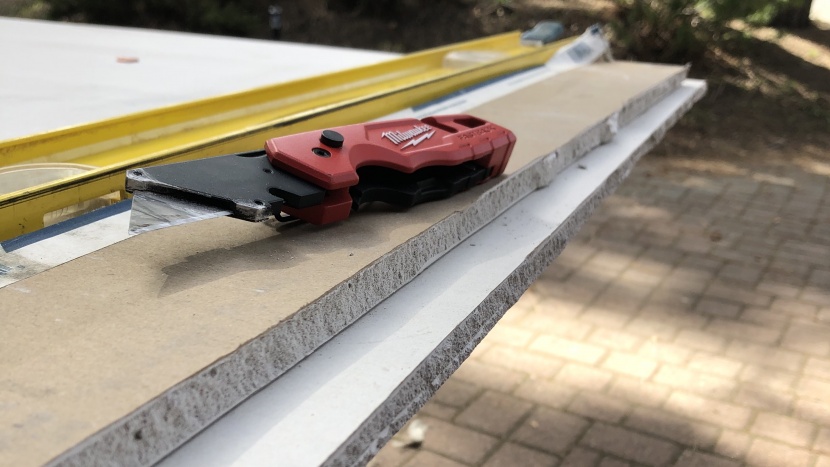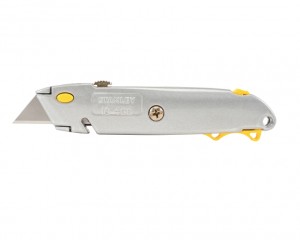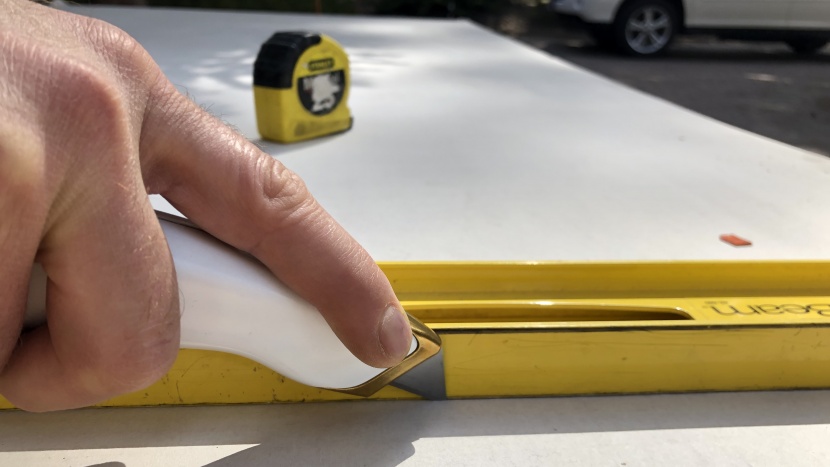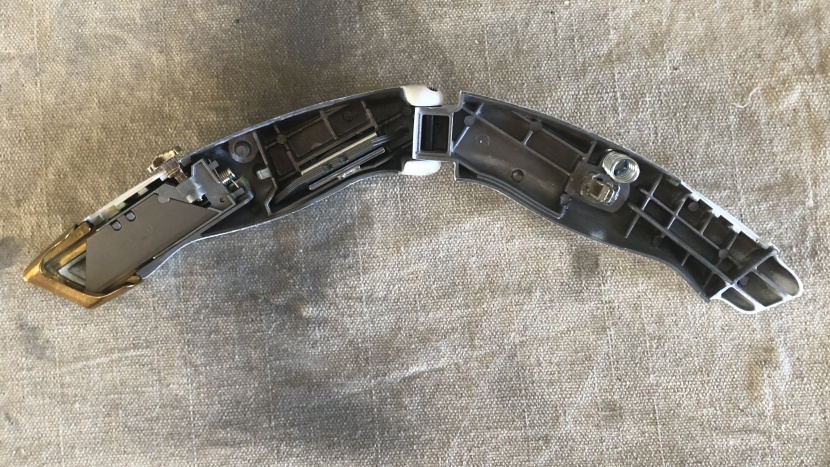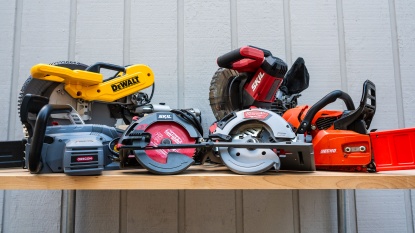We cut to the chase and purchased 9 of the leading utility knives on the market to determine the best options out there. Our rigorous testing was conceived and executed by professional tradesmen, DIYers, and garage craftsmen as well as those who work in our shipping and receiving department. With the data derived from on-the-job experience and function-specific lab testing, we isolated products that are best suited to distinct user needs as well as general use.
We've got the scoop on other tool accessories, including basics like stud finders and PPE like safety glasses. And don't forget about our hand-selected list of tools in the biz.
Our Top Picks
9 Best Utility Knives
The LENOX Utility Knife Quick-Change addresses all of the common problems inherent in the classic utility knife design. The grip is comfortable and effective, nicely curved to match the shape of the hand in a thumb-out grip position, which prompts precision and pressure on the blade. The internal blade storage is easy to access, and the no-tool blade release is quick and easy. The combination of these two features makes switching to a sharp blade a breeze. Moreover, the buttons are big and grippy, making it easy to operate all aspects of the knife. Finally, the internal blade storage clamp goes a long way to eliminate rattling while at the same time helping to keep the extra blades as sharp as ever.
While the design of the knife is certainly well thought out, the manufacturing could be better. For example, there is a bit of play in the moving parts, particularly in the blade carriage. Additionally, the handle closure tolerance is a bit larger than we would have liked. We did not experience any failures during our testing. However, if you're going to use this blade for frequent, heavy-duty work, you might want to consider a model with fewer moving parts. That said, for most non-professional work, this model will be a godsend.
The Kobalt Utility With 11 Blades is one heck of a pocket knife, boasting sound construction and plenty of space for a firm grip. Much like a traditional pocket knife, this tool has a spring lock that is quite secure when its blade is in the open position. We really liked this feature because the tool offers users leverage comparable to non-folding knives while eliminating concerns of an unexpected closure. Additionally, when the knife is folded up, you can rest assured that the stiff pocket clip will keep the knife in place even when squatting or high-stepping.
Despite the burly construction and secure pocket clip, this model isn't without shortcomings. First off, though not impossible, unfolding the knife is quite hard to manage with one hand. However, closing it without the use of two hands is even more difficult — bordering on dangerous — and we don't recommend attempting it. Finally, there is no onboard blade storage. Counterbalancing this issue is a blade swiping system that is simple and effective. All in all, this is a quality knife at a competitive price.
If you like simple, affordable, dependable tools, then the Stanley Classic 99 is likely your kind of knife. This blade has a narrow handle but offers ample grip. It has just one moving part, and it stores up to 10 extra blades. Speaking to the quality and simplicity of the design, the blade carriage has very little play, which is more than we can say about much of the competition.
Our main concern about the 99E is that its two halves are secured with a screw that has to be backed out when you want to change out a blade. While it's not that big of a deal, it does require a screwdriver or a penny if you're in a pinch. Annoyingly, the loose blades that are stored in the handle will spill out if you're not mindful to turn the handle flat when you separate the two halves. Yet, we found this model to be an effective tool designed to take a clobbering and keep on cutting.
The OLFA LA-X stands apart from the competition on account of its long blade (3.25") that is scored to allow the top section to be broken off to expose a sharper tip section. The blade's length offers a real advantage when cutting along a feature such as a straight edge or in a slot. Conversely, when precision work is required, simply retract the blade to its shortest setting to increase rigidity. Moreover, the handle's rubber inlay combined with the flaring shape enhances the grip and, thus, the cutting control.
The LA-X is a practical tool, often owned in conjunction with a traditional utility knife, but it's not without some shortfalls worth mentioning. For starters, the blade carriage is constructed of plastic which is not nearly as durable as metal. The blade lock is also a bit flimsy. We did not experience any issues with these parts; however, we would not recommend this model as a stand-alone for heavy use. With that in mind, when you need the extra blade length or a fresh edge in quick order, reach for this tool.
The Outdoor Edge SlideWinder is a compact knife that is easy to keep on hand. At just 1/4 inch thick and sporting a pocket clip, there's no reason not to carry this multi-tool on your person every day. The blade is easy to swap, and the built-in Phillips and flathead screwdrivers work well, particularly when compared to other multi-tools in the class.
Although the stainless steel frame is sufficiently sturdy, the blade carriage lock is an issue. We found it to be stiff and not always reliable. For those with larger hands, you may find this tool only allows for a three-finger grip, making prolonged use uncomfortable. Lastly, a nominal concern (albeit an important one after 5 o'clock) is the onboard bottle opener. It will work, but its narrow mouth struggles to bite into bottle caps. All in all, this compact tool can be quite helpful in a pinch and happily unimposing when not in use.
The Milwaukee Fastback Folding is a do-it-all knife that conveniently folds and clips to a pocket or belt. The knife easily opens one-handed and provides 5 1/2 inches of gripping real estate. There are several nifty tools built into the unit, including a gut hook and a cord cutter. The magnetized, five-blade storage arm that folds out opposite the blade further adds to this model's utility. The construction is solid, and the open and close lock is well thought out.
If pressed to find some issues with this cutting tool, we would say that if you are doing a lot of work with a utility knife (e.g., on a framing project or a remodel), the act of unfolding the tool may become annoying. Additionally, it is a bit bulky for front pocket storage, particularly when squatting. Minor shortcomings aside, this tool is built for heavy use and fits in well in a professional kit or shop drawer.
If you need a sharp blade for quick tasks requiring the control of a four-finger grip, the compact folding Mossy Oak 2-Pack Folding Pocket is the ticket. The blade release system is simple and effective, requiring no tools to operate, and the all-aluminum body of this pocket knife is light and strong.
Some conveniences are sacrificed to keep this tool simple. For one, there is no onboard blade storage. Additionally, there is no lock securing the blade in the closed position, although it does lock open. Finally, the clip on our model was not as tight as we would have liked it to be — it slipped out of our front pocket more than once during field tests. That said, the clip can be removed with a star drive and bent into a more secure position if needed. Despite the shortcomings, this model is a reliable little knife that won't take up too much room in your pocket.
The Gerber EAB Lite is set up more like a proper pocket knife than a folding utility knife. Clean lines and craftsmanship define its refined look, while the finger guard on the cutting edge makes for a practical four-finger grip.
Despite the utilitarian design, this utility knife is by no means a good choice for heavy use. Construction quality is not to blame for this; the EAB simply lacks the level of comfort we desire for routine handling. However, the blade is reliable. It also easily clips onto your cash and cards, so you can have it accessible and ready to use when you need it.
The Stanley 10-499 QuickChange is a souped-up version of the 99E. That classic workhorse has been upgraded with push-button blade release and onboard blade storage. Additionally, a gut hook was added for tasks like peeling tight-fitting plastic wrap. In addition to these add-ons, this tool maintains simplicity and ease of use.
Although we dig this model captures much of its predecessor's simplicity, we have some concerns about the additional plastic components. Plastic locks and springs are potential weak points, and this tool has two such parts. That said, we didn't experience any failures in our testing. When it comes down to it, this is an excellent alternative to the 99E if you must have no-tool blade changes.
Why Trust GearLab
Before settling on products to test, we did our due diligence researching the utility knife market. We then purchased every product at full cost, used them in specific tests, and carried them while working on job sites. The knives we tested were brought to a construction site and handed out to the workers. The merits and shortcomings of each model were discussed at the end of the workday. Now that's information you can trust.
GearLab has been testing tools for over half a decade. Whether it's lawn mowers, circular saws (both cordless and corded), or impact drivers, we know tools. Our testers and writers have worked in the trades and continue fabricating everything from robots to furniture in their home shops. Senior Review Editor Nick Miley headed up this review. He earned his bread by swinging a hammer for a custom home outfit and building wooden boats for many years. Eventually, he transferred his skills to industrial rope access and composite repair. These experiences have taught him the value of a sharp and readily available tool.
Analysis and Test Results
To find the cutting-edge utility knives, we developed several practical evaluations that highlight the tools that excel in specific tasks and those that lean more towards general use. These evaluations inform the metrics or the particular categories that collectively describe a quality utility tool. These categories are grip, sturdiness, convenience, and pocketing. The following is a detailed description of the evaluations and the best performers.
Grip
The grip defines the power and leverage you can exert onto the cutting edge. Since we used the Stanley 1992 blade on all the tools (except the OLFA), the grip is the most crucial feature. If the grip is short or narrow, the control and power over the blade decreases. To assess grip, we cut various materials, including cardboard, garden hoses, rubber molding, nylon webbing, sheetrock, wooden dowels, and braided rope.
More rigid tools offer an optimal grip. The LENOX provides the best grip overall and was particularly favored by those with larger hands. This tool's pistol grip allows the fingers to sink into the curvature for added purchase. Though it's thinner along the spine and cased with rubber to limit slips, the OLFA LA-X boasts a similar handle. And though they lack articulation, both of the Stanley knives — the E99 and 10-499 — offer a reliable, four-finger grip.
The folding knives offer a substantially inferior grip than their rigid counterparts, as they have uneven surfaces and narrow spines that make prolonged cutting tasks uncomfortable. That said, the Milwaukee and the Kobolt offer the most gripping real estate of the folding models and would pass muster on a job site.
Sturdiness
Quality of knife design and construction can go a long way in mitigating the risk of injury. Our sturdiness metric looks at the manufacturing tolerances, as seen in the fit of parts and the action of moving components. Construction material is also assessed. We took apart the knives when possible to see if parts could be tightened or replaced, as even the best equipment wears and requires maintenance.
Leading the pack in this metric is the Gerber EAB Lite. In typical Gerber fashion, the manufacturing is nearly flawless. The lock fits precisely, and there is zero wobble in the blade. In contrast, the Stanley E99 isn't much of a looker, but the fit of the handle's two halves is tight and even. If we're nit-picky, the blade carriage has a bit of play. Nonetheless, the model's durability is legendary, and the steel components speak to this reputation.
As their actions are smooth, the lock secure, and the moving parts tight-fitting, both the Milwaukee and the Kobalt folding tools are deserving of honorable mentions. A few of the knives had manufacturing issues. The Mossy Oak has a weak pocket clip, the Outdoor Edge has some problems with its lock and carriage, and the OFLA has some thin plastic parts.
Convenience
What's the point of having a utility knife if using it is inconvenient? The main features that make a knife convenient are onboard blade storage, the ability to change blades without tools, and smooth operation. This latter point is particularly crucial with folding knives, where opening with one hand can be challenging.
Three models stand out in this evaluation — the Milwaukee Fastback, the LENOX, and the Stanley 10-499. These models check every box with easy access blade storage, push-button blade release, and ease of operation. The Fastback's design is very slick; its easy swing blade locks open and closed with the push of a button. Additionally, the blade storage folds out like an arm, and the blades are held in place with a magnet.
For various reasons, we had trouble smoothly operating the Kobalt, E99, and Gerber models. The Kobalt requires two hands to operate, the E99 requires a screwdriver to swap the blade, and the Gerber has both issues.
Pocketing
The pocketing metric assesses how well each product fits into the various pockets on work pants, specifically the front and the thigh pockets. We also test how well the products stay in the pocket. If the tool has a clip, we checked if it will fit over bulky denim seams.
For the most part, the models with pocket clips crushed this metric — EAB Lite, Outdoor Edge, and Kobalt. These tools can securely fasten to any pocket, bad, or your favorite belt. The Milwaukee was an exception as it is substantially broader, longer, and thus more uncomfortable than its peers. A notable difference on the EAB Lite is the shallow arch of its clip, which makes it better suited to pinching credit cards and cash than a pocket. Finally, the Mossy Oak's clip was too loose, resulting in multiple incidents of it being squeezed out of pockets when testers squatted.
As for the rigid knives, these models best fit into work bags or a side pocket. The lack of a clip attached to these knives, particularly the Stanley models, makes them prone to slipping out of pockets. The OLFA is an exception, as its rubber grip helps keep the knife where you put it, but this also makes it tricky to get in and out of a pocket.
Conclusion
Our review covers some of the best utility knives on the market. We made countless cuts of common materials ranging from garden hoses to rubber molding, sheetrock to wooden dowels, and tubular webbing to braided rope. These practical tasks outlined each tool's preferred use and showed which models were built for heavy use. We hope our review has answered your questions so you can cut through the marketing crud with confidence.
—Nick Miley



